#Exercise Physiology Tools
Explore tagged Tumblr posts
Text
#Sports Science Equipment#Sports Science#Exercise Physiology#Sports Physiology#Biomecenics#Sports Biomechanics#National Center of Excellence#Sports Rehab#Sports Recovery#Sports Exercise Science#Health and Exercise Science#Exercise Sports Science#Strength and Conditioning#Sports Physiology Equipment#Rehabilitation equipment#Rehab & Recovery#Exercise Physiology Tools#Science of Kinesiology#Biomechanics Equipment
0 notes
Text
💪Ryder Steele’s Muscle Gain Instruction Manual. 💪
A surface-level yet comprehensive beginner’s guide to working out/body building/gaining muscle written by a tboy with a degree in human physiology, with tboys in mind. Speed training, toning, and cardio/lung health training will not be explored.
(Part 1) Diet. Talking about food, their molecules and how the body responds.
An aspect of bodybuilding/exercizing that is just as important as the weights and workouts themselves. Generally, the more a human does, the more nutrition they need in every sense.
Protein is needed to survive as a human, 0.8 grams per kilogram of weight MINIMUM. (source) To gain muscle you need to consume more protein than that. 1 gram per pound of body is a good goal.
There are additional ingredients, Amino Acids, you can ingest to give your body more of what it needs to build muscle. The most common is creatine, and it can be found naturally in foods or bought alone. 14mg per pound is a good dose, (source) but you could do as low as you like.
Carbohydrates, fats, vitamins, minerals, and water are other things essential to keep you running, but aren’t the building block of muscle.
For vitamins, minerals, and water be sure to get the daily recommended dose. It’s worth considering a little more than recommend water, potassium, magnesium, and sodium in your diet for adequate muscle usage before and during working out. Also, a bit more calcium in general for muscle movement and the strength your bones must gain to support stronger muscles and weight loads.
For carbohydrates and fats, it’s important to have adequate levels of these. The body uses carbohydrates for energy first and mainly, then uses fats, then proteins. How much? Well it depends on how much you care about the image of your body, and what your goals are.
The Bulk is for people who want to gain muscle and mass a bit quicker. There is clean bulking and dirty bulking. Dirty bulking is eating a lot without much regard to amounts. Clean bulking is to gain muscle mass while keeping your body fat percentage at relatively the same level.
The Cut is for people who want to reduce their body fat percentage. Eating at a slight/moderate deficit to force the body to consume fat cells as energy. High protein is still consumed.
Before working out, you should consume something 30-40 minutes before starting. Preworkout, a caffeinated substance, or complex carbohydrates to give you the energy needed to begin and not crash.
After working out, you should consume a good portion of your daily proteins 30 minutes to four hours later.
(Part 2)Working out. Utilizing and ripping the telomeres of your muscles and forming neural pathways.
To build muscle, you need to utilize the muscles. To get bigger muscles, your body needs to move with more resistance than what it normally does. Weight acts as the resistance.
Warming up is an important first step to working out, as you need to prime your body’s systems and cells. Heart rate is the primary thing to warm up, because using muscles required your heart pump harder and faster. 5-10 minutes of warmup minimum of cardio is best. The intensity of this cardio is your choice. Dancing, fast walking, jogging/running, jump rope, cycling, etc. are good. Stretching is also a good precursor to the warmup as the warmup uses your muscles also. It’s a process, but its important to warm up properly to avoid tightness, cramps, or even things snapping.
The weightlifting a complicated and highly discussed thing. There are hundreds of motions across gym machines, tools, and muscles for you to chose from. Which ones you do depend on what is available, and the muscles you want to work. Write stuff down if you must. Here is an exercise dictionary.
Muscle names are good to know to decide which motions to do. Look at this diagram to learn, and build your own encyclopedia and routine.
Frequency of working out is important. If your body does not use muscles, they deteriorate. You can work certain muscles more frequently than others. Just keep adequate rest. You may see things like push/pull day, arm day. This is the type of motions and muscles focused. Dedicating a workout session/day to one muscle group helps keep track of avoiding overuse. See Rest for more. Once a week at minimum you should work a muscle group to keep it from deteriorating. Here’s an example: Sunday rest. Monday arms&core. Tuesday whole back. Wednesday rest. Thursday whole arms. Friday rest. Saturday whole legs.
Duration of working the muscle during a session/day impacts its growth. A rep is one time going through a motion. Sets is how many times you do a group of reps. 3x15 pushups is I’m doing 15 pushups. Rest. 15 more. Rest. 15 more. Three sets of fifteen. To build endourance, lower weight at higher reps. To build mass and strength, higher weight at lower reps.
Finally, the weight heaviness. You should slightly push your muscles to start, then base your weight patterns off of what is a good amount of strain for you. The more you challenge/strain yourself, the more it will hurt and build muscle mass. Also, the faster you increase the weight your muscles fight against, the higher the risk of injury. However, if you stick to a weight that is not challenging, your muscles will not grow. There must always be some element of challenge your muscles must always be chasing to keep up with. Thats what growing is. For example: I’ve been bicep curling single dumbbells of 10 pounds for months. 12 pounds is a comfortable challenge, and I can do 15 also but not the whole set. So, I may warm up with 1 set of 10lbs. Two sets of 12lbs, then finish with one set of 15 at lower reps. The number of reps per set could be 15,12,10,6. Decreasing reps while increasing weight to prep the body, but not injure too much.
(Part 3) Rest. Your body building new muscle, and preparing to work again.
In between sets of exercise, you need to rest your muscles for enough time for them to become reloaded with their energy, ATP. ~1 minute for heavily lifting. Ensure you’re breathing well also to give your blood oxygen. Deeper, healthy breaths during rest is good.
After training it’s recommended to give a muscle group ~48 hours of rest to rebuild the fibers. Rest means not training it, but of course if you need to use them, use them. Additionally, you can still be active and rest, doing a thing called active rest. Doing nothing at all, which has its benefits, is called passive rest.
Sleep is your body’s way of storing information and taking out the cerebral trash. During sleep your body produces growth hormone, your brain works to retain all of the information you and your body learned during the day, and generally refreshes itself. Napping can e beneficial also if it doesn't interfere with getting the minimum 8-10 hours depending on your age group.
Thank you for reading! If you have any questions, would like help creating workout plans, or would like a bit of praise or encouragement feel free to reach out. Also if there are any errors. Now go have fun!
#androphilia#autoandrophilia#forcemasc#forced masculinization#weightlifting#body building#finally here!
236 notes
·
View notes
Note
I have character A whose born female, small in stature and well trained in hand to hand combat and character B whose born male, a few feet taller, fucking huge and has had to rely on strength his whole life. Realistically how can two people like this fight and for how long? what kind of qualifications could character A have to help her beat character B in hand to hand combat? at what point does strength win over strategy or vice versa in a fight? does any of this make sense lol
Nope.
Okay, so, how long can Character A fight? As long as she needs to, which based on your assessment, shouldn't be too long.
Character B cannot fight. Unless they have training that you're not disclosing, they won't be effective.
“My relies on strength to fight,” is a bit like saying, “my character drives their car via their sheer physical strength.” It's not how this works.
Unarmed combat isn't about strength, it's about a precise understanding of human physiology, and exploiting the limitations of it.
For example: You may have noticed your knees only bend in one direction, however, this is a lie, your knees can bend in any direction they want to, provided a small application of force in the correct point which will permanently expand your knee's ability to move in this new direction. It's not strength, or at least, not a meaningful amount, it's about looking at your opponent's body as a mechanical system, and then selectively breaking it until it stops trying to break yours. The funny thing about this is, if you don't know what to do humans are obnoxiously durable. Unless you get lucky, you can literally rip limbs off and still fail to kill them.
A lot of the philosophy of strength fighting is built off a misunderstanding. Force is important. However, when it comes to weapons, the weapon itself amplifies and delivers that force. For example: hammers are often portrayed as strength weapon. You'll see them being carried around by huge bulky bruiser types (when it's not played for laughs, anyway.) However, real sledges are not extremely heavy. A real sledge can get as heavy as ~20lbs (~9kg) (normal ones are less than half that), which is extraordinarily heavy for a weapon, but getting it swinging isn't that hard. It's designed to be swung. Once it's at speed, it will connect with a lot more force than you could generate based on raw physical strength. The basic physics are that you get the hammer's head moving significantly faster than the haft where you're holding it. The basic woodcutters strike where you start with one hand at the bottom of the haft and one near the head, then slide it down the haft as you swing makes it even easier to get it moving.
(Worth noting, there are sledgehammers designed for exercise, rather than as tools, and these get a lot heavier, but they're for building up muscles. Which, to be fair, there's nothing wrong with a character who's absolutely ripped, and there are ways they can use that to their advantage, but it doesn't help them fight, just like it doesn't help them drive.)
Beyond that, as we've mentioned a lot recently, swords really are not a strength weapon. It's a long razor blade, which needs to be carefully applied to your opponent's soft screamy parts, not their armor.
The one weapon that really is a strength weapon is the bow. If you're a professional archer (using historically authentic weapons, rather than mechanical compounds bows) there's a very real potential you'll be ripped. You're pulling a lot of weight in your shoulders. Of course, bows are also very high maintenance weapons, which isn't often reflected, but weapon maintenance is often an underrepresented in general.
When talking about unarmed combat, the amount of force necessary is shockingly low. Again, it's about exploiting the body's limitations. Knowing where to put pressure lets you use your opponent's body against them. Most people, “normal people,” don't look at other human beings as 100-200lbs of ambulatory meat stretched across a pulley system. When you start learning anatomy for the purposes of combat, the ability to break another human being starts to become frighteningly simple.
So what happens? She quickly neutralizes her opponent.
How long does that take? Depending on training? Could be less than five seconds. Certainly less than a minute.
What does neutralize mean in this context? I dunno. It could mean that he's subdued and gradually losing consciousness. It could mean that he'll never dance or play piano again. It could mean his next date is with the coroner. All of these are reasonable potential outcomes depending on who she is, and what she trained to do.
Remember what I said near the beginning. (Assuming she has a practical combat background) her job is to break his body before he does the same to hers. If he's a big bruiser type with no context of violence outside of John Wayne films and high school scuffles, she could kill him. In a lot of cases, she needs to, because she doesn't know what his background is, and the faster he is permanently scratched off her threats column the better. From her perspective, leaving him on the board poses an immediate and critical threat to her life.
This is the other thing about violence, you don't know what your opponent can or will do. When you're assessing a threat like this, you need to have a plan to remove them. “Do unto them before they can do unto you.” That doesn't always mean, “kill them,” but we're talking about a walking mountain who's at least seven feet tall. At that point, life altering injuries start to sound a lot like reasonable force, and justifiable lethal force is just around the corner. Depending on his behavior, it may already have arrived.
So, how long does this take? Not long.
Strength only wins out over strategy if the strategies are poor or poorly implemented, if she has combat training, that shouldn't be a consideration. Beyond that, people are far more predictable than we like to see ourselves as. Good combat training includes a surprising amount of practical insight into how people behave. Realistically, he's not going to be able to do anything she hasn't trained to counter, at least not if he doesn't have some training of his own. And, again, even if he was to have training, his strength wouldn't be the deciding factor, his training would be the important consideration.
-Starke
This blog is supported through Patreon. Patrons get access to new posts three days early, and direct access to us through Discord. If you’re already a Patron, thank you. If you’d like to support us, please consider becoming a Patron.
464 notes
·
View notes
Text
How Trauma Affects The Body
Trauma can have a significant impact on the body, both in the short-term and long-term. Trauma can trigger the "fight or flight" response, which is a natural physiological response that prepares the body to respond to a perceived threat. This response can lead to a variety of physical symptoms, including increased heart rate, rapid breathing, and muscle tension.
Over time, trauma can also cause chronic physical symptoms, including headaches, chronic pain, gastrointestinal problems, and immune system dysfunction. Trauma can also affect the nervous system, leading to conditions such as anxiety, depression, and post-traumatic stress disorder (PTSD).
Breathing exercises can be a helpful tool for releasing trauma from the body. One effective technique is deep breathing, also known as diaphragmatic breathing. This involves taking slow, deep breaths, expanding the belly as you inhale and exhaling slowly.
Another technique is alternate nostril breathing, which involves breathing in through one nostril and out through the other while blocking the opposite nostril with your finger. This can help balance the nervous system and promote relaxation.
Other techniques that can be helpful include progressive muscle relaxation, where you tense and relax different muscle groups in your body, and visualization exercises, where you imagine a peaceful scene or experience. It's important to note that these techniques can be helpful for managing symptoms, but they should not be used as a substitute for professional treatment for trauma or other mental health conditions.
631 notes
·
View notes
Text
Putting this in a pinned post to make it easy to find/share. We all know how Tumblr is about things (and to be fair, I'm terrible and inconsistent as hell with tags).
Link to the "shoulder release" document:
Notes about this guide:
This is a WIP, and still very much in the rough draft phase. Please forgive typos/errors. I literally haven't done a single edit yet.
The document focuses on releasing shoulders as a way to treat neck tension and migraines. Seriously, just trust me. It helps.
Carpal tunnel? Tennis elbow? Golfer's elbow? AC (acromioclavicular) joint injury? Rotator cuff problems? Tight upper back? Sporadic numbness in your arm? Seriously, just try the muscles already listed. You'll likely find at least some relief. Like, if it involves the upper body, release your shoulders.
I've done my best to make this able to be understood by people without massage training. So if it seems like it's covering really "obvious" info, that's intentional. Just skip the section if you already know things.
A lot of massage therapists may balk at me telling you to dig around in your own armpit. We're taught in school to avoid the area. Why? Because there's a crap ton of nerves and blood vessels there. *Which is precisely why releasing this area is so powerful.* There's also a ton of muscle (on yes, basically everybody) here that will protect all those structures. It's honestly really safe so long as you stick to "In pain, refrain!" And read the other rules too.
90% of the time, the culprit is one of the four muscles listed (or any combination of them). If you are someone who exercises a lot/does yoga/is otherwise pretty physically active, you are more likely to fall into the 10% of people who will have their issue somewhere else/it will just be really hard to find. So bear that in mind.
Sadly, this sort of thing will probably never be a "one and done" type of deal. Most of the things we do every day steadily build up to cause problems, and you have to constantly work to undo that entropy. So save these notes for future you.
And just in case you want to know what the hell qualifies me to make this sort of document, here are my "quals."
My first career attempt was nursing. While this did not go well (doctors don't really appreciate autistic students willing to question their authority) I learned a shit ton about the body. I became a student teacher for the anatomy and physiology class because I was so good at it (and that professor used to teach the pre-med students). A&P is now literally one of my special interests.
8 years as a licensed massage therapist focused exclusively on injury therapy. I studied Rolfing techniques, and primarily used trigger point therapy, structural integration, and myofascial release as my tools. Clients liked to joke that going to see me was like seeing the physical therapist (they weren't wrong).
Some of the stuff I share is literally self taught through "following the tension" in clients bodies. Like, I developed some of my protocols. And then practiced and refined them over 100s of bodies. The goal was always the most efficient and least painful way to achieve lasting release.
I eventually destroyed my shoulder doing massage (which was injured long before this career due to an AC joint sprain gotten when I was 20). Bonus, this means I'm *very* practiced at releasing my own shoulders.
I'm now a mechanical engineer, which just means I now have the engineering knowledge to understand to the force transferrence patterns I saw in clients all the time. Kinesiology is the same thing as statics and dynamics.
Hopefully that helps put perspective into things. I'll update this post as new versions of the document come out. I have a ton on my plate right now (who am I joking; I always have a ton on my plate), so please be patient waiting for updates.
#massage#active release techniques#shoulder release#migraine treatment#self massage#trigger point therapy
35 notes
·
View notes
Text
Tips & Tools for Releasing Stored Trauma in Your Body
🌻Somatic Experiencing: Developed by Dr. Peter Levine, Somatic Experiencing can release trauma locked in the body. This method is the result of a combination of stress physiology, psychology, neuroscience, medical biophysics and indigenous healing practices. (Videos on youtube)
🌻Mindfulness and Movements: going for a walk, bike ride, Boxing, Martial arts, yoga (or trauma-informed yoga), or dancing. People who get into martial arts or boxing are often those who were traumatized in the past. They’re carrying a lot of anger and fighting is a great release for them. Exercise helps your body burn off adrenaline, release endorphins, calm your nervous system, and relieve stress.
Release Trapped Emotions: 🍀How to release anger from the body - somatic healing tool 🍀Somatic Exercises for ANGER: Release Anger in Under 5 Minutes 🍀Youtube Playlist: Trauma Healing, Somatic Therapy, Self Havening, Nervous system regulation
🌻 Havening Technique is a somatosensory self-comforting therapy to change the brain to de-traumatize the memory and remove its negative effects from our psyche and body. It has a calming effect on the Amygdala and the Limbic system. 🌼Exercise: Havening Technique for Rapid Stress & Anxiety Relief 🌼Exercise: Self-Havening with nature ambience to let go of painful feelings 🌼Video: Using Havening Techniques to rapidly erase a traumatic memory (Certified Practitioner guides them through a healing session)
🌻Eye Movement Desensitization and Reprocessing (EMDR) is a psychotherapy technique often used to treat anxiety and PTSD. It incorporates rhythmic eye movements while recalling traumatic experiences. This combo changes how the memory is stored in the brain and allow you to process the trauma fully.
🌻Sound & Vibrational Healing: Sound healing has become all the rage in the health and wellness world. It involves using the power of vibration – from tuning forks, singing bowls, or gongs – to relax the mind and body.
🌻Breathwork is an intentional method of breathing that helps your body relax by bypassing your conscious mind. Trauma can overstimulate the body’s sympathetic nervous system (aka your body’s ‘fight-or-flight��� response). Breathwork settles it down.
Informative videos & Experts on Attachment style healing: 🌼Dr Kim Sage, licensed psychologist 🌼Dr. Nicole LePera (theholisticpsychologist) 🌼Briana MacWilliam 🌼Candace van Dell 🌼Heidi Priebe
Other informative Videos on Trauma: 🌻Small traumas in a "normal" family and attachment: Gabor Maté - The Myth of Normal: Trauma, Illness, and Healing in a Toxic Culture 🌻Uncovering Triggers and Pattern for Healing: Dr Gabor Maté 🌻Understanding trapped emotions in the body and footage of how wild animals release trauma
Article: How Trauma Is Stored in the Body (+ How to Release It)
Article: 20 self-care practices for complex trauma survivors
#trauma#healing#attachment styles#trauma informed#somatic#yoga#psychology#neuroscience#mindfulness#Exercise#emdr#eft tapping#sound healing#Breathwork#soothing#nervous system#self care#my post#my information collection#research#trauma healing#attachment trauma#insecure attachment#anxious attachment#inner healing#therapy#psychologytoday#polyvagal#nervous system regulation#relationships
172 notes
·
View notes
Text
The Creed
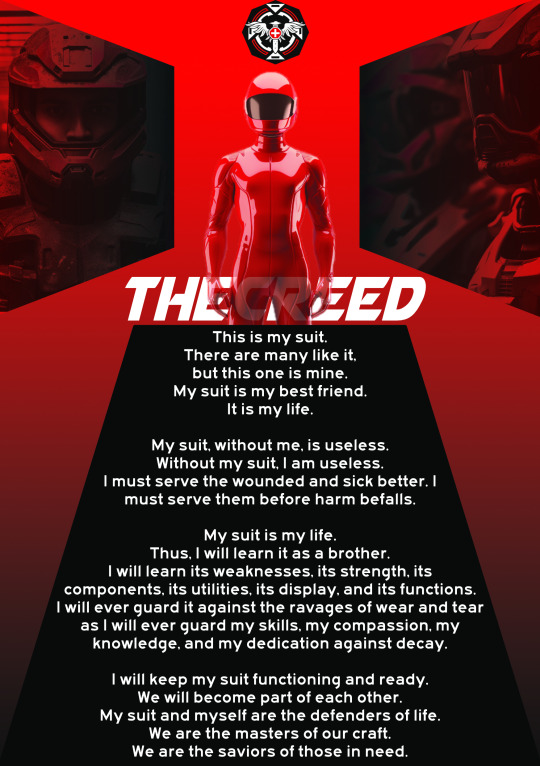
With a directive from the instructors, H2U8M's voice gradually faded into the digital abyss, leaving the recruits once again in the embrace of the silent void. The instructors, like unseen puppeteers, observed the platoon's reactions through the telemetry data and AI analyses.
In the dark and motionless expanse of their armored suits, the recruits were left to dwell on H2U8M's words. The instructors monitored the physiological responses, the subtle shifts in neural patterns, seeking signs of resonance or resistance to this unorthodox experience.
KO10T: "Let them marinate in this silence a bit longer. It's fascinating to see how they adapt, how their minds react to the unexpected."
6DG05: "Agreed, KO10T. This reveals more about their mental fortitude than we anticipated. The power of isolation, focus, and introspection in a suit – it's a potent cocktail."
As the recruits lingered in the sensory void, their thoughts echoed within the confined space of their helmets. The Mark IV Armour Suits, normally a conduit for information and interaction, now became vessels of solitude and self-reflection. The instructors, orchestrating this peculiar exercise, awaited the fruits of their experimental endeavor.

O10T's stern voice echoed through the recruits' helmets as their HUDs flickered to life with the opening of the Voice and Video Channel. The recruits found themselves virtually face-to-face with the imposing figure of KO10T, his expression obscured by the mirrored visor of his own Mark IV Armour Suit.
"Recruits," KO10T's voice resonated with authority, "welcome back to the realm of the operational. You've just experienced a taste of the isolation your suits can impose. It's a reminder that within these suits, focus is your ally, distraction your enemy."
He paced in front of the recruits, his movements crisp and purposeful, a visual representation of the discipline he expected from each of them.
"In the next ten days, you will become intimately acquainted with your Mark IV Armour Suits. These suits are more than mere armor; they are an extension of yourself, a tool that amplifies your capabilities. You will train together, face challenges, and ensure that every component of your suit functions flawlessly."
The recruits remained immobilized, absorbing KO10T's words as the anticipation of the upcoming training period hung in the air.
"Remember," KO10T continued, "you are not alone in this. Your fellow recruits are your comrades, and together, you will form a cohesive unit. Now, let the training begin."

With those words, the Voice and Video Channel closed, plunging the recruits back into a digital silence, their minds now focused on the challenges that awaited them in the days to come.
The HUD lit up with an eerie glow, displaying the suit creed in bold letters and intricate designs. The recruits stood in a formation, their suits locked in place, as the words scrolled across their vision.
"This is my suit. There are many like it, but this one is mine. My suit is my best friend. It is my life. I must master it as I must master my life.
The voice of the AI echoed through their earpieces, guiding them through the creed with a hypnotic rhythm.
My suit, without me, is useless. Without my suit, I am useless.
As the creed unfolded, the recruits were prompted to repeat each line after the AI.
I must serve the wounded and sick better than any who would harm them. I must serve them before harm befalls.
The words became imprinted in their minds, merging with the conditioning they had undergone.
My suit is my life. Thus, I will learn it as a brother. I will learn its weaknesses, its strength, its components, its utilities, its display, and its functions.
The sleek, red visors of their helmets displayed the text in a way that felt almost invasive, seeping into their consciousness.
I will ever guard it against the ravages of wear and tear as I will ever guard my skills, my compassion, my knowledge, and my dedication against decay. I will keep my suit functioning and ready.
The repeated chant filled the training room, creating an otherworldly chorus. The recruits, unable to move, focused solely on the luminous display of the creed.
We will become part of each other. My suit and myself are the defenders of life. We are the masters of our craft. We are the saviors of those in need.
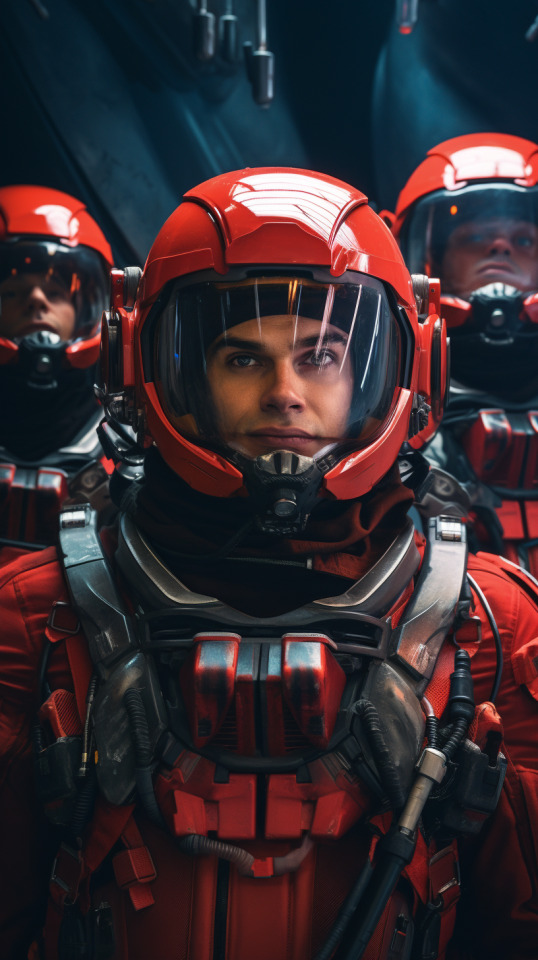
The AI adjusted the pacing, ensuring each recruit spoke in unison, creating a symphony of obedience. The final lines resonated, and the HUD dimmed, leaving the recruits in a momentary silence.
KO10T and 6DG05 stood at the periphery, their faces half-shrouded by the crimson glow of the recruits' HUD displays. As the recruits echoed the creed, the instructors exchanged glances, their smiles bearing the weight of experience.
"Ah, the first immersion," KO10T mused, the reflected light dancing in his eyes. "I remember it like it was yesterday. The awe, the submission, the transformation."
6DG05 nodded in agreement, his gaze fixed on the recruits like a puppeteer admiring his marionettes. "We were like them once, young and untested. But now, we are the architects of their reality, the masters of this symphony of obedience."
The room hummed with the rhythmic cadence of the recruits' recitation, a chorus of conformity carefully orchestrated by the unseen puppet masters. The HUD displays glowed with fervor, projecting the suit creed into the minds of the recruits with relentless precision.
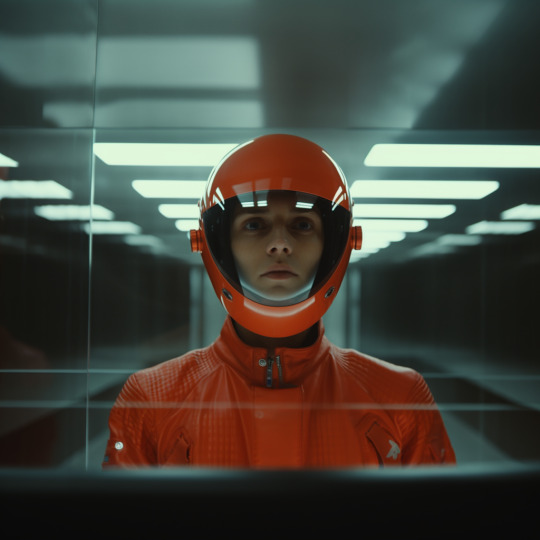
"Their minds, like clay, molded by the creed and conditioned by the suit," KO10T said, his voice tinged with a sense of accomplishment. "Soon, they will not question; they will act instinctively, like well-tuned instruments in the grand performance of the corps."
6DG05's smile widened, a blend of satisfaction and detachment. "They think they wear the suits. Little do they know, the suits wear us"
KO10T and 6DG05 shared a knowing glance, their expressions concealed behind the crimson visors of their seasoned armor.
The HUD displays fed them the recruits' physiological responses, a canvas of compliance painted in shades of commitment and conformity.
"Their minds," KO10T continued, "become extensions of the AI, guided by the parameters set forth by the corps"
"Our minds," 6DG05 repeated, a mantra that transcended the confines of the HUD. "Entwined with the technology, entangled in the narrative. They believe they shape it, yet it shapes them in return."
"Little do they know," KO10T repeated, his words a whispered mantra of their own. "Little do they know that the true puppet masters are not the ones who wear the suits, but the ones who control the strings, hidden in the shadows of obedience."
The HUD displays flickered with real-time data, a cascade of responses to the creed. Physiological signatures intertwined with vocalizations, forming a feedback loop of conditioning.
"You know we are as controlled as they will soon be…" 6DG05 trailed off, acknowledging the paradox that bound both the puppet masters and the puppets in their intricate dance.
KO10T, his visor reflecting the flickering HUD displays, nodded knowingly. "Yes, but we enjoy it."
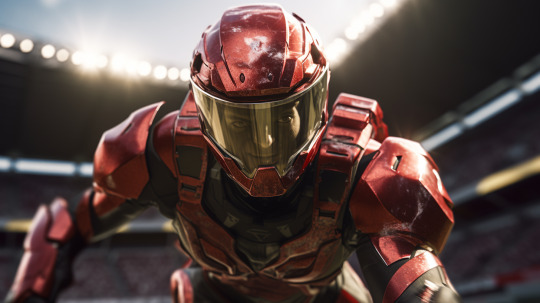
As they observed the recruits, still caught in the echo of the suit creed, KO10T and 6DG05 acknowledged the shared embrace of their own conditioning. In the shadows of command, they found a perverse enjoyment, a fulfillment that mirrored the very control they exerted over others, even if they knew they were subject to control themselves.
"In the next ten days," KO10T's voice echoed through the recruits' helmets, "you will become one with your suits. They will be your second skin, your sanctuary, your shield. From this moment onward, you will only open your visors for nourishment breaks. The rest of the time, you live, breathe, and exist within the confines of the Mark IV Armour Suit and its Helmet"
The recruits, visors now transparent, listened intently as 6DG05 continued the explanation.
"Sleep will be an integral part of your training. You will sleep in the suits, allowing them to become an extension of your very being. And when nature calls, you will use the waste evacuation system of the chastity device within the suits. Efficiency is paramount, and the suit ensures that every moment contributes to your readiness."
The instructors observed the recruits' reactions, their expressions hidden behind the visors but observable to the AI. The system read a mix of anticipation, curiosity, and a touch of apprehension. The recruits, now fully immersed in the symbiotic relationship with their suits, absorbed the instructions with the stoicism expected of them.
"Remember," KO10T emphasized, "this is a crucial phase of your training. It's not just about physical endurance but mental fortitude. Your suits will become an extension of your will, and you will learn to navigate the challenges they present. In the end, you emerge not just as paramedics but as embodiments of discipline and dedication."
The instruction continued: "You will start now with going through the obstacle course. It will feel different because the suit add mass and bulk you up. You'll go through it as a pair and we count the time and compare to the time you needed without the suits"
The recruits, now fully clad in their Mark IV Armour Suits, marched towards the looming obstacle course. The suits added mass and bulk, transforming the once-familiar landscape of the course into an uncharted territory. The instructors, with a devious twinkle in their eyes, explained the challenge that lay ahead.
"The obstacle course will be different this time. The suit adds a new dimension, a weighty presence that demands synchronization between man and machine. You'll navigate it as a pair, and we'll be watching closely, comparing your times to the ones without the suits."

The HUD transitioned into simulated mission mode, casting a digital hue over the recruits' vision. The obstacle course, once a routine challenge, now took on a surreal, almost otherworldly quality. Each obstacle became a potential battlefield, and every movement had the weight of a tactical maneuver.
As they ventured forth, the recruits felt the enhanced strength of the suits, the amalgamation of man and machine. The obstacle course, a microcosm of the challenges they would face, demanded not only physical prowess but also an acute mental connection with the suit. It was a dance of precision and power, a symphony of human determination and technological augmentation.
The instructors observed, their expressions a blend of scrutiny and satisfaction. The recruits, now navigating the course in a synchronized dance with their suits, moved with a newfound grace and efficiency. The Mark IV Armour Suits, once perceived as tools, now felt like companions in the journey ahead – silent partners in a mission that transcended the physical boundaries of the obstacle course.
As the recruits progressed, the obstacle course morphed into a simulated mission scenario. The HUD projected tactical information, turning each obstacle into a strategic checkpoint. The recruits, guided by the immersive display, maneuvered through the challenges with a sense of purpose and determination.
he instructors, clad in the same formidable Mark IV Armour Suits, observed the recruits as they navigated the obstacle course with precision and determination. The HUDs within their helmets displayed real-time data, capturing the nuanced details of each recruit's performance. KO10T and 6DG05, the puppet masters in their crimson exoskeletons, exchanged glances and initiated a silent conversation through the secure communication link.
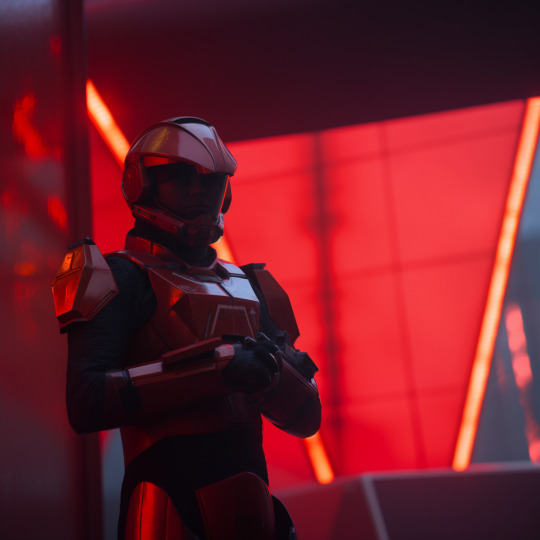
KO10T: "Impressive. The suits have transformed them into a cohesive unit. Look at IU664, leading with confidence."
6DG05: "And A7T9R, adapting quickly to the added mass. The neural conditioning is paying off."
6DG05: "The silence drill served its purpose. They're adapting faster than expected. The neural synchronization is remarkable."
As the recruits conquered each obstacle, the instructors continued to analyze the HUD data, delving into the intricacies of their performance. The suits, once seen as tools, were now instrumental in shaping the recruits into a formidable paramedic force.
KO10T: "This generation will surpass our achievements. The neural enhancements are taking root."
The instructors, their voices masked by the helmeted visages, shared a nod of agreement.
KO10T: "Ten days in those suits. They'll come out smelling like roses, won't they?"
6DG05: "More like a bouquet of tactical paramedic excellence. I'm sure the stench of dedication has a unique fragrance."
The instructors shared a chuckle, their banter a brief respite from the intensity of the training. The recruits, encapsulated in their suits, continued their drills with unwavering focus.
KO10T: "Imagine the aroma when they finally pop those visors open. A symphony of commitment, if you will."
6DG05: "Ah, the sweet scent of conditioned neural pathways. It's an acquired taste, I'm sure."
As they exchanged jokes, the instructors maintained a keen eye on the HUD data, assessing the recruits' adaptability and performance.
KO10T: "Let's see how they handle a simulated mass casualty incident. Deploying virtual patients now."
As the recruits moved through the training area, their HUDs filled with simulated patients in distress. The AI projected vital signs, injuries, and urgent medical needs. The recruits, clad in their powered suits, assessed the virtual casualties and executed the necessary procedures with a blend of efficiency and precision.
6DG05: "Impressive. The AI-generated scenarios test their decision-making under pressure. It's not just about physical prowess; it's about adapting to dynamic situations."
KO10T: "And the suits facilitate that adaptation. The recruits are experiencing the symbiosis of human intuition and AI assistance."
The simulated obstacles and patients provided a comprehensive evaluation of the recruits' ability to handle complex emergencies. The AI continuously adjusted the scenarios based on their responses, ensuring a dynamic and challenging training environment.
6DG05: "This isn't just about completing a course. It's about honing their skills in unpredictable situations. The AI gives us real-time insights into their thought processes."
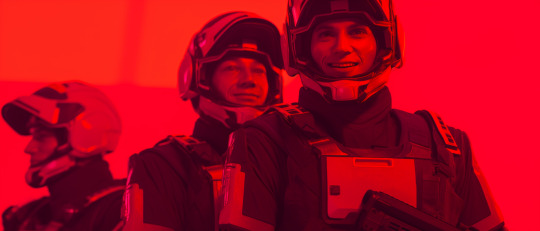
KO10T, standing beside the regeneration station, addressed the recruits with a stoic demeanor. The station, a fusion of technology and comfort, awaited the tactical paramedics like a dormant giant ready to embrace them.
KO10T: "Recruits, welcome to the regeneration stations. In the field, these will be your sanctuaries between missions. Here, you rest, recharge, and prepare for the challenges ahead. The connection you establish with the station is not just physical; it's a merging of man and machine."
The recruits, still adjusting to the surreal reality of the Mark IV Armour Suits, observed as KO10T explained the process. The tubes snaking from the wall connected seamlessly to ports in the armor, creating an intimate link between the tactical paramedics and the regeneration station.
KO10T: "The station contours to your body, providing a customized and ergonomic sleeping experience. It's not just about physical recuperation; it's a mental reset as well. The AI in your suits will sync with the station, optimizing the regeneration process based on your unique needs."
6DG05, monitoring the recruits' reactions, added a touch of dry humor to the explanation.
6DG05: "Think of it as a high-tech bed that knows you better than you know yourself. The station ensures you're at your peak when the next call comes in."
The recruits, some still wide-eyed from the intensity of the simulations, approached the regeneration stations with a mixture of curiosity and fatigue. The rhythmic hum of the station's systems seemed to beckon them into a realm where man and machine seamlessly coexisted.
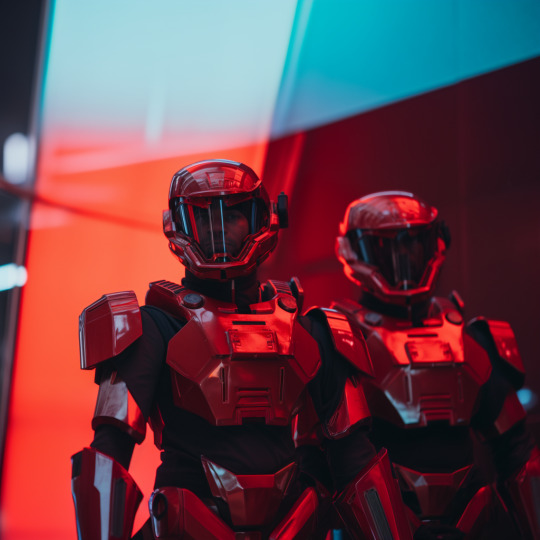
KO10T: "Get acquainted with the stations. In the field, these moments of rest are precious. They are where you recharge not just your bodies, but your resolve. Now, rest up. Tomorrow brings more challenges, and you'll face them well-prepared."
IU664 and H2U8M, lying in their regeneration stations side by side, initiated a private channel through the AI, their helmets displaying a dim glow as they engaged in a subdued conversation.
IU664: "Quite a first day, huh? I never imagined the suits would be this… immersive."
H2U8M: "Yeah, it's like living in a different world. I mean, I expected challenges, but this… it's beyond anything I trained for."
IU664: "The obstacle course, the simulated missions, it's all designed to push us to our limits. And then there's this regeneration station. Feels like something out of a sci-fi nightmare."
H2U8M: "Nightmare or not, it's our reality now. Did you see the way they monitor our every move, even our private conversations?"
IU664: "The AI's always watching, always listening. They want us synchronized, not just in action but in thought. It's like they're molding us into a single, cohesive unit."
H2U8M: "And what about that mantra they made us recite? 'The suits wear us.' What the hell does that even mean?"
IU664: "I don't know, but it sounds like they're trying to blur the lines between man and machine, make us dependent on these suits for everything. It's… unsettling."
H2U8M: "True. And did you notice how they talked about the regeneration station contouring to our bodies? Like it's meant to become an extension of us. This is more than just training; it's indoctrination."
IU664: "Indoctrination into what, though? The paramedic corps, sure, but it feels like there's more to it. Like we're being groomed for something beyond just saving lives."
H2U8M: "I'm not sure I want to know what's beyond saving lives. But we're in this together, IU664. We need to watch out for each other."
IU664: "Agreed. We navigate this nightmare together, and we'll come out the other side, whatever that side looks like."
As IU664 and H2U8M continued their conversation, the AI subtly guided their exchange, analyzing the nuances of their words and expressions. Eventually, a gentle prompt from the AI signaled them to rest.

AI Prompt: "Rest is essential for optimal performance. Sleep well, recruits. Tomorrow brings new challenges."
With the precision of an automated orchestra conductor, the AI roused IU664 and H2U8M from their regenerative slumber. The helmets' dim glow returned, gradually illuminating the confined space within the regeneration station.
AI Prompt: "Good morning, recruits. Your sleep has been monitored and optimized for peak performance. Suits are functioning within optimal parameters. Initiating wake-up sequence."
The suits adjusted, providing a subtle nudge to assist the recruits as they transitioned from the horizontal repose of the regeneration stations to the upright stance of wakefulness. The helmets cleared to reveal the familiar surroundings of the training facility.
AI Prompt: "Current status report: physiological indicators within standard ranges, sleep cycles aligned with optimal patterns. Ready for the day's activities."
As IU664 and H2U8M emerged from their stations, the AI continued its informational updates.
AI Prompt: "Nutrient levels replenished. Waste evacuation system ready for use. Your participation in today's training will contribute to further optimization. Remember, recruits, the suits are here to enhance your capabilities. Embrace the integration."
The dim glow of the helmets intensified, signifying full activation.
In the bathroom, the recruits were guided by the AI to attend to personal hygiene. With a gentle hiss, the visors of their Mark IV Armour Suits ascended, allowing them to see their reflections in the mirrors. The sterile environment of the bathroom was briefly exposed to their vision.
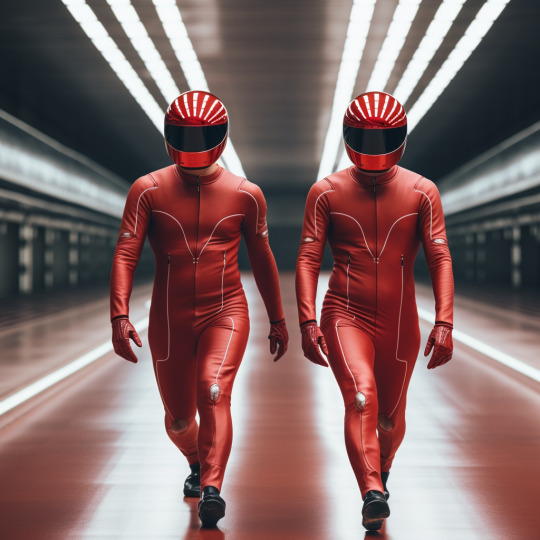
AI Prompt: "Recruits, please proceed with dental and facial hygiene. This brief pause allows for personal care routines. Make use of the allocated time efficiently."
As the recruits inspected their reflections, the AI prompted them through the steps of cleaning their teeth and face. Each movement, synchronized with the suit's interface, became a well-choreographed routine. The suits, once again, proved their versatility, adapting seamlessly to the recruits' daily rituals.
AI Prompt: "Maintaining personal cleanliness is essential. A disciplined routine contributes to overall readiness. Conclude your hygiene activities promptly."
The visors descended once the hygiene routine was completed, reestablishing the enclosed environment of the suit.
In orderly rows, the recruits aligned themselves as directed by the AI, waiting for their turn in the morning chow hall. The ambient hum of the facility accompanied the recruits' anticipation as they stood encased in their Mark IV Armour Suits.
AI Prompt: "Recruits, as you await your nourishment, recite the Paramedic Corps Pledge. Let the words reinforce your commitment and purpose."
The AI's voice resonated through their helmets, guiding them through the recitation of the pledge. The recruits, in unison, echoed the words that encapsulated the ideals and dedication of the paramedic corps. The rhythmic cadence of their voices, amplified by the suits' communication system, created a sense of unity within the assembly.
Recruits (in unison): "In service, we stand united. With courage, we face the unknown. For the wounded, we are the healers. In the face of chaos, we bring order. Our armor is our shield; our duty is our oath. We are unwavering in our resolve."
AI Prompt: "Well done, recruits. The pledge echoes in unity, a testament to your shared purpose. Nourishment dispensing will commence shortly."
One by one, they approached the serving station, where trays were meticulously loaded with carefully measured portions of nutrient-rich food.
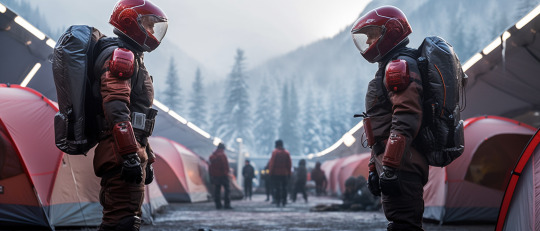
As each recruit received their tray, the visors of their helmets lifted, revealing faces temporarily unshrouded by the sleek, reflective exterior.
IU664's gaze lingered on H2U8M, a rare moment of unobscured connection in the regimented routine of the paramedic corps. Across the table, their crimson-armored forms seemed to soften, if only momentarily, as the visors retracted for the morning meal.
IU664 (raising his tea cup): Quite the view without the visor, isn't it? Feels almost human.
H2U8M (nodding): Yeah, it's like a brief respite from the metal embrace. Almost forgot how faces look.
IU664 (smirking): Faces, expressions… sometimes, I wonder if the suit's trying to erase our memories of being regular folks.
H2U8M (smiling): Regular folks, huh? Feels like a lifetime ago. How's the morning treating you, IU?
IU664 (leaning back slightly): Same old routine. The suit, the pills, the chow. Makes you appreciate the little things, like a cup of tea.
Instructor H2U8M approached the table, his visor retracted, revealing a face that mirrored familiarity more than the polished crimson armour ever could. The recruits paused mid-conversation, acknowledging his presence.
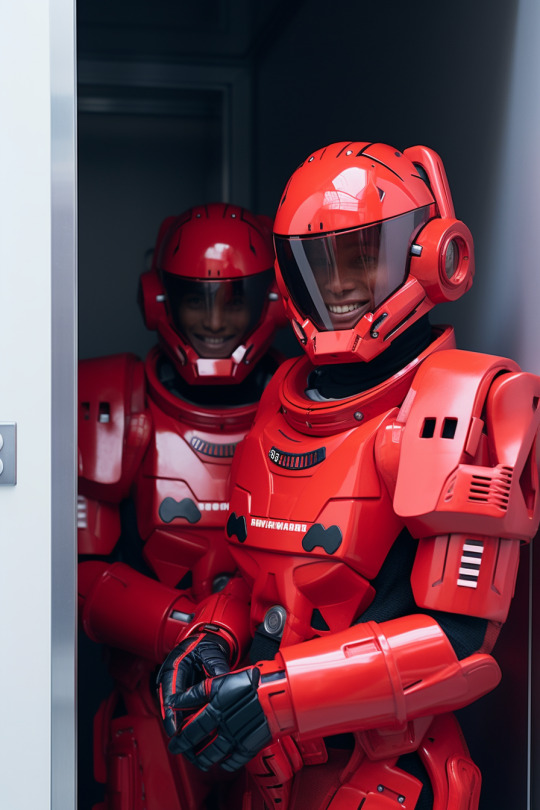
Instructor H2U8M: Morning, recruits. How's the day treating you so far?
IU664 (saluting): Good morning, Instructor. Just enjoying our moment of visor freedom.
Instructor H2U8M (smirking): A rare luxury, isn't it? Thought I'd drop by and have a word. How are you both settling into the routine?
H2U8M (recruit): It's… different, sir. Getting used to the suit, the protocols. Feels like living in a controlled environment.
Instructor H2U8M: Controlled, yes, but for a reason. You're not just paramedics; you're the first line of defence. The suit is your ally, your shield.
IU664 (nodding): Understood, sir. It's just a bit overwhelming at times.
Instructor H2U8M: Change always is. But adaptability is a trait we cultivate. You two can talk to us, share your thoughts. It's crucial to maintain mental resilience.
H2U8M (recruit): Thank you, Instructor. It's good to know there's support.
Instructor H2U8M (leaning in): One more thing before I go. Did you take your morning medication? Compliance is key.
IU664 and H2U8M both nod, lifting their empty cups as proof.
Instructor H2U8M (smiling): Good. Stay focused, follow the routine. You'll find your rhythm.
IU664 and H2U8M finish their meal, return the trays and align with the rest of their platoon in a line in the chow hall. The platoon stood in a disciplined line, visors descended, reducing the outside world to a dim and muted existence.
In the quietude of the visors, they waited for the next set of instructions. The rhythmic hum of the ventilation systems and the distant murmur of conversations created a peculiar sense of isolation, even in the midst of their comrades.
The AI-generated prompt blinked on their HUDs, signalling the resumption of their training schedule. The visors intensified their opacity, shutting out the chow hall and its sounds completely. The recruits stood in silent anticipation, their thoughts contained within the sealed confines of the Mark IV Armour Suits.
The visors dimmed further, reducing the ambient light to a soft glow as the AI initiated the recitation of the Suit Pledge. In unison, the recruits began to recite the words that had become a daily ritual, their voices echoing within the confines of their helmets.
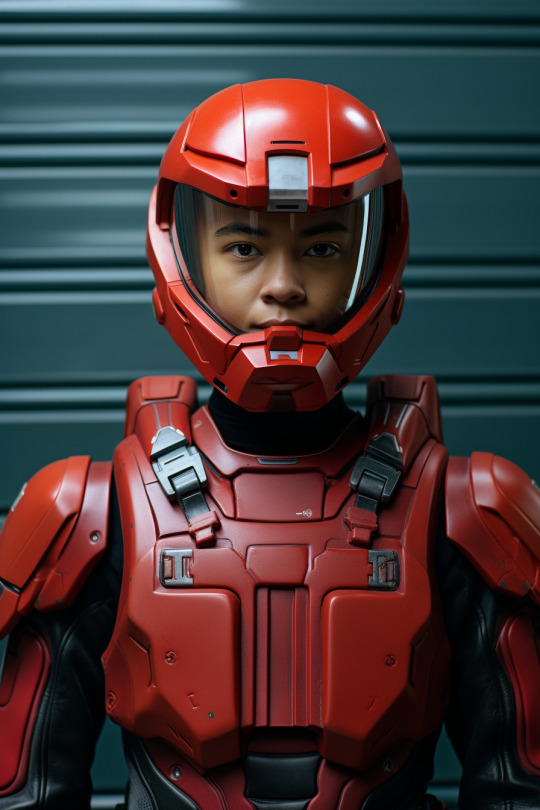
"This is my suit. There are many like it, but this one is mine."
IU664's voice resonated with a blend of familiarity and determination. The suit, once a foreign entity, now clung to him like a second skin, a testament to the symbiotic relationship forged through training.
"My suit is my best friend. It is my life."
H2U8M echoed the sentiment, feeling the weight of the armor that had become an extension of self. The camaraderie among the recruits was palpable, bound not just by shared experiences but by the collective acknowledgment of their dedication.
"I must master it as I must master my life."
As the words lingered in the air, a sense of purpose enveloped the recruits. The mastery of the suit was not just a technical feat but a commitment to the profound responsibility they carried as paramedics.
"My suit, without me, is useless. Without my suit, I am useless."
The recruits felt the truth of these lines deep within, an understanding that their effectiveness relied on the seamless integration of man and machine. The suit was both shield and sword, a conduit for their skills and compassion.
"I must serve the wounded and sick better than any who would harm them."
The pledge invoked a sense of duty, a calling to excel in the face of adversity. In the dimly lit chow hall, the recruits stood with a shared resolve to be unwavering guardians of life.
"I must serve them before harm befalls."
The words hung in the air, a solemn promise to act preemptively, to be the shield against the encroaching shadows of affliction. The recruits embraced this commitment with a silent determination.
"My suit is my life. Thus, I will learn it as a brother."
In the quietude of their enclosed helmets, the recruits reflected on the intimate relationship they had cultivated with their suits. It was a bond forged through training, trials, and an unspoken understanding.
"I will learn its weaknesses, its strength, its components, its utilities, its display, and its functions."
The HUD within their visors pulsed with data, a visual representation of the suit's intricacies. The recruits, now attuned to the nuances, navigated the complexities with a proficiency born of repetition.
"I will ever guard it against the ravages of wear and tear."
The pledge resonated with the recruits' dedication to the meticulous care of their suits. The constant exposure to harsh conditions demanded vigilance, and they embraced the responsibility with a sense of stewardship.
"As I will ever guard my skills, my compassion, my knowledge, and my dedication against decay."
IU664 and H2U8M felt a surge of pride as the pledge emphasized not just the physical aspects of the suit but the intangible qualities within themselves. The commitment to personal growth and resilience became a beacon in their shared journey.
"I will keep my suit functioning and ready. We will become part of each other."
The recruits felt the synergy between man and machine, a fusion that transcended mere functionality. The suit was not just an instrument; it was an ally, an inseparable companion in the pursuit of their noble mission.
"My suit and myself are the defenders of life. We are the masters of our craft. We are the saviors of those in need."
As the final words reverberated, a collective sense of purpose filled the air. The recruits, bound by the solemnity of the pledge, stood as guardians, masters, and saviors, ready to face the challenges that awaited them in the world beyond the visors.
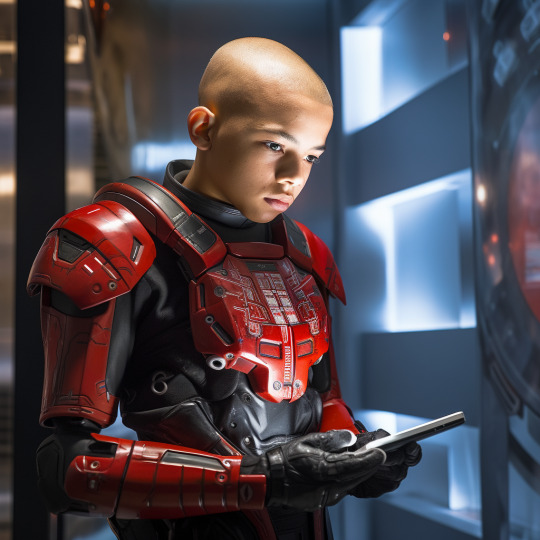
16 notes
·
View notes
Note
I’ve been reading Unmasking Autism and really enjoying it, the exercises have been enlightening and giving me a lot of new insight on my life, and I’m really grateful for all the tools and advice you included. I figured it might be worth asking you this because you’ve clearly done a lot of research and spoken with a variety of autistic people about their experiences.
I was wondering if you would have advice on a specific experience I tend to notice; often if I see a pet peeve of mine somewhere (and this particularly sucks because my biggest ones are factual errors regarding something I struggle with) it’s very hard for me to move on from seeing it. I can’t forget it and move past it and it continues to upset me for a long time, but of course I don’t want to come off as aggressive by correcting someone (especially because I have such a strong emotional response and wouldn’t want to project that anger on someone who just didn’t know better).
Is there a term for this type of experience that you know of? Or any advice you would give for preventing your brain from sticking on one thought?
Yeah, that's perseveration or rumination, I'd say. And I get it -- I used to get so angry and tense whenever a podcast I was listening to got a fact wrong, or a teacher of mine did, or a boss, and then just breezed along onto the next discussion point without ever correcting it. I would just repeat the correction in my head over and over, or write it down, or write a pissed off little email about it, because I could not get over it and I didn't get the chance to share it.
In my case, this fixating on other people's wrongness only fed into my misanthropy (at the time) and anger and sense of disconnection from everybody.
Now, there are plenty of situations where simply speaking up and correcting the incorrect statement on the fly is the responsible thing to do. Somebody gets misgendered? Interrupt to correct it. Someone in a work meeting has a crucial sales figure wrong? Piping up to correct it is important.
Where it gets dicier is when the correction is more complicated or the issue seems moot given the situation, even if the truth of the matter is really important to you. For instance, someone makes an off-hand comment about their phone giving them dopamine when that's not really how the neurotransmitter works, and popular misconceptions about the role dopamine plays in task completion and discovery leads to a lot of damaging conclusions.... and suddenly now I'm delivering an impassioned thousand word rant to a person who really just used the phrase as a metaphor and never really thought about whether it was neurologically true anyway and doesn't really need to hear that it's incorrect right now.
In situations like those, I think it is important to have the skill of regulating distress and detaching from unwanted thoughts. And there's a whole array of psychological techniques for this that you can try. There's mindfulness. There's dialectical behavioral therapy. There's imagining the thought as a bubble and letting it float up to the surface and pop, or picturing it as a leaf blowing away on the breeze or whatever else. There's also working on your anxiety -- I fixate on other people's wrongness less now that I'm off caffeine and less impatient and problem-finding. There's meditation, and grounding techniques. There's working on one's outlook towards other people. and there's working on one's boundaries and accepting that how other people think and feel is not your problem or something you even should have the power to control.
those are just some options. some may work for you, some won't. i know i had to get my physiological anxiety reduced (by quitting caffeine, getting regular exercise, AND by not working too much) in order to be more patient with such things. and i also had to do some inner work in accepting that other people's minds are not my mind and that their thoughts and feelings cannot hurt me and exist outside of me and independent of me. i also had to work on healthy assertiveness so i come across as less pissy and aggressive when i do step in to correct. and i just generally had to work on not ruminating on any of my anxieties as much as i used to. im much better at letting go of things now and learning that took years.
your mileage may vary depending on the specifics of how getting stuck like this feels to you! the fastest, simplest solution is just noticing youre stuck and deciding you dont want to be stuck and so consciously choosing a distracting activity that will occupy your mind instead.
38 notes
·
View notes
Text
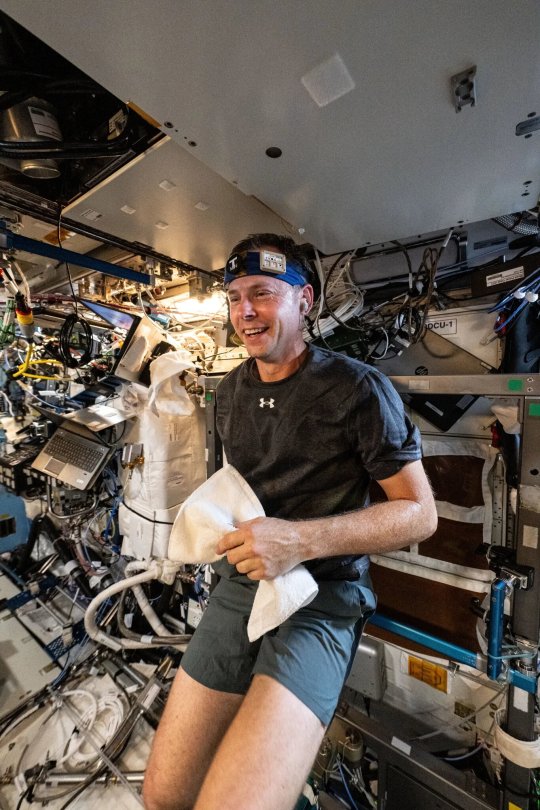

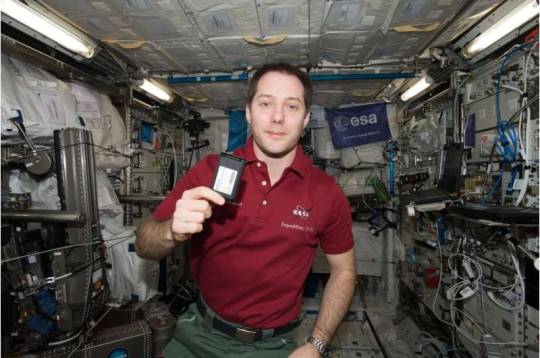
Wearable tech for space station research
Many of us wear devices that count our steps, measure our heart rate, track sleep patterns, and more. This information can help us make healthy decisions—research shows the devices encourage people to move more, for example—and could flag possible problems, such as an irregular heartbeat.
Wearable monitors also have become common tools for research on human health, including studies on the International Space Station. Astronauts have worn special watches, headbands, vests, and other devices to help scientists examine sleep quality, effectiveness of exercise, heart health, and more.
Warm to the core
Spaceflight can affect body temperature regulation and daily rhythms due to factors such as the absence of convection (a natural process that transfers heat away from the body) and changes in the cardiovascular and metabolic systems.
A current investigation from ESA (European Space Agency), Thermo-Mini or T-Mini examines how the body regulates its core temperature during spaceflight. The study uses a non-invasive headband monitor that astronauts can wear for hours at a time.
Data from the monitor allow researchers to determine the effect on body temperature from environmental and physiological factors such as room temperature and humidity, time of day, and physical stress. The same type of sensor is already used on Earth for research in clinical environments, such as improving incubators, and studies of how hotter environments affect human health.
Thermolab, an earlier ESA investigation, examined thermoregulatory and cardiovascular adaptations during rest and exercise in microgravity. Researchers found that core body temperature rises higher and faster during exercise in space than on Earth and that the increase was sustained during rest, a phenomenon that could affect the health of crew members on long-term spaceflight.
The finding also raises questions about the thermoregulatory set point humans are assumed to have as well as our ability to adapt to climate change on Earth.
To sleep, perchance to dream
Spaceflight is known to disrupt sleep-wake patterns. Actiwatch Spectrum, a device worn on the wrist, contains an accelerometer to measure motion and photodetectors to monitor ambient lighting. It is an upgrade of previous technology used on the space station to monitor the length and quality of crew member sleep.
Data from earlier missions show that crew members slept significantly less during spaceflight than before and after. The Actiwatch Sleep-Long investigation used an earlier version of the device to examine how ambient light affects the sleep-wake cycle and found an association between sleep deficiency and changes during spaceflight in circadian patterns, or the body's response to a normal 24-hour light and dark cycle.
Follow-up studies are testing lighting systems to address these effects and help astronauts maintain healthy circadian rhythms.
Wearable Monitoring tested a lightweight vest with embedded sensors to monitor heart rate and breathing patterns during sleep and help determine whether changes in heart activity affect sleep quality. The technology offers a significant advantage by monitoring heart activity without waking the test subject and could help patients on Earth with sleep disorders.
Researchers reported positive performance and good quality of recorded signals, suggesting that the vest can contribute to comprehensive monitoring of individual health on future spaceflight and in some settings on Earth as well.
These and other studies support development of countermeasures to improve sleep for crew members, helping to maintain alertness and lessen fatigue during missions.
(Not) waiting to exhale
Humans exhale carbon dioxide and too much of it can build up in closed environments, causing headaches, dizziness, and other symptoms. Spacecraft have systems to remove this substance from cabin air, but pockets of carbon dioxide can form and be difficult to detect and remove.
Personal CO2 Monitor tested specially designed sensors attached to clothing to monitor the wearer's immediate surroundings. Researchers reported that the devices functioned adequately as either crew-worn or static monitors, an important step toward using them to determine how carbon dioxide behaves in enclosed systems like spacecraft.
Radiation in real time
EVARM, an investigation from CSA (Canadian Space Agency), used small wireless dosimeters carried in a pocket to measure radiation exposure during spacewalks. The data showed that this method is a feasible way to measure radiation exposure, which could help focus routine dosage monitoring where it is most needed. Any shielding and countermeasures developed also could help protect people who work in high-radiation areas on Earth.
ESA's Active Dosimeter tested a radiation dosimeter worn by crew members to measure changes in their exposure over time based on the space station's orbit and altitude, the solar cycle, and solar flares. Measurements from the device allowed researchers to analyze radiation dosage across an entire space mission.
The Active Dosimeter also was among the instruments used to measure radiation on NASA's Orion spacecraft during its 25.5-day uncrewed Artemis I mission around the moon and back in 2022.
Another device tested on the space station and then on Artemis I, AstroRad Vest is designed to protect astronauts from solar particle events. Researchers used these and other radiation measuring devices to show that Orion's design can protect its crew from potentially hazardous radiation levels during lunar missions.
The International Space Station serves as an important testbed for these technologies and many others being developed for future missions to the moon and beyond.
TOP IMAGE: NASA astronaut Nick Hague wears the T-mini device while exercising. Credit: NASA
CENTRE IMAGE: NASA astronaut Sunita Williams wears an Actiwatch as she conducts research. Credit: NASA
LOWER IMAGE: ESA astronaut Thomas Pesquet holds one of the mobile units for the Active Dosimeter study. Credit: NASA
2 notes
·
View notes
Note
So, how do you think tails flight works? Can he fly in your verse?
In most canons I think Tails' flight works the same way classic Sonic's super-peel-out does- it's a cartoon superpower thing and it only needs as much explanation as we personally find enriching or edifying. He's hardly the most improbable flier of the team considering Knuckles doesn't even pretend to have a form of propulsion, he's just on some wizard shit we guess.
In my personal Sonic AU, all mobians have one inborn superpower, and what you get is a bit of a tossup due to a lot of factors; Tails is a Levitator type, which is to say he's able to make objects float and control their trajectory somewhat. Obviously he's the object he has the most control over, and he's also the heaviest object he can manage since he's in relatively poor health and also young.
Powers are a bit like a muscle- you have to find the right way to stretch and exercise them without straining them. Where someone's "inherent" limit lies / how much stronger they can possibly get is, needless to say, a whole can of worms about nature vs. nurture with no clear answer as far as understood by contemporary science. In Tails' case, the last time he saw a medical doctor, the agreement was that it'd be a good idea to gently exercise his powers as this might improve his health- the correlation between power strength and physical vitality goes both ways.
(Not that you can jog your way out of a chronic condition, but as long as it's not going to hurt you, being in good shape might help your body live with said condition)
Tails is a little self-conscious that he feels like a powerless weenie compared to Sonic; he mostly uses his levitation powers to access things off of high shelves or keep his tools all nearby when working.
Sonic, meanwhile, is pretty close to winning the superhero lottery- while he'd strictly be classified as having Super Speed for legal purposes, he achieves this by mechanical movement, as in literally pumping his legs rather than phasing through reality or something, so it means his power is a bodily-enhancement type power that makes him physiologically extremely strong and resilient. He's also a virtually unheard-of 'double dip' in that he ALSO has seemingly unrelated wind powers... which shouldn't at all be how powers work but it's fine we're fine we're sure nothing's wrong with Sonic.
#Sonic the Hedgehog#Sonic the Remix#the design in that art and the worlds AU tag are defunct/no longer canon but Sonic having a little glowing problem somewhere in his ribs is
21 notes
·
View notes
Text
Title: Breathlessness and dysfunctional breathing in patients with postural orthostatic tachycardia syndrome (POTS): The impact of a physiotherapy intervention
Date: January 2020 Published in: Autonomic Neuroscience Publicly available: It is now.
Citation: Reilly, C. C., Floyd, S. V., Lee, K., Warwick, G., James, S., Gall, N., & Rafferty, G. F. (2020). Breathlessness and dysfunctional breathing in patients with postural orthostatic tachycardia syndrome (pots): The impact of a physiotherapy intervention. Autonomic Neuroscience, 223, 102601. https://doi.org/https://doi.org/10.1016/j.autneu.2019.102601
Full text
Abbreviations:
BPAT: breathing pattern assessment tool
COPD: chronic obstructive pulmonary disease
DB: dysfunctional breathing
HVS: hyperventilation syndrome
POTS: postural orthostatic tachycardia syndrome
Article summary
Abstract
Introduction
POTS is a chronic syndrome with complex symptoms of orthostatic intolerance. It is defined as an increase in heart rate of ≥ 30bpm in adults (≥40 bpm in children) within 10 minutes of standing with no orthostatic drop in blood pressure.
POTS is more common in women. Symptoms can be debilitating (impairment comparable to congestive heart failure and COPD) and include palpitations, light headedness/syncope, chest discomfort, breathlessness, neuropathic pain, chronic fatigue, poor sleep efficience, gastrointestinal symptoms, syncope, cognitive slowing, and psychological distress.
Breathlessness is a common symptom in POTS. Breathlessness is often attributed to changes in breathing pattern, frequency, and/or quality occuring alongside cardiac symptoms. Breathlessness can be episodic, triggered by physical activity, stressful thoughts and events.
Dysfunctional breathing (DB) is an umbrella term describing breathing disorders where chronic changes in breathing pattern result in breathlessness and other symptoms without respiratory or cardiac disease. The most studied form of DB is hyperventilation syndrome (HVS)
Boulding et al. (2016) suggest classifying dysfunctional breathing into the following: 1) Hyperventilation syndrome (a respiratory pattern associated with symptoms both related to respiratory alkalosis and independent of hypocapnia), 2) Periodic deep sighing (frequent sighing with an irregular breathing pattern), 3) Thoracis dominant breathing (a respiratory pattern occurring separate to somatic disease may be considered dysfunctional and results in dyspnoea), 4) Forced abdominal expiration (inappropriate and excessive use of abdominal muscle contraction to aid expiration), 5) Thoraco-abdominal asynchrony (a respiratory pattern in which there is delay between rib cage and abdominal contraction resulting in ineffective breathing movements)
Patients with POTS often undergo extensive investigations due to the complexity of potential comorbidities but there is no guidance or consensus on the assessment of breathlessness.
Methods
Retrospective study of POTS patients referred to repiratory physiotherapy
Respiratory physiotherapy outpatient's referral criteria: tests performed and identification of DB/HVS are explained
Physiotherapy assessment and outcome measures
A standardised physiotherapy assessment of symptoms was performed on all patients (details provided in the paper)
Physiotherapy intervention:
The physiotherapy intervention was standaradised in terms of education and breathing re-training exercises and was delivered by a consultant physiotherapist of a highly specialised respiratory physiotherapist. Each patient was assessed and treated by the same physiotherapist.
Physiotherapy treatment
The educational component focused on patient's understanding of respiratory physiology and the mind-body link
Breathing re-training intervention involved teaching breathing control (details provided). The breathing retraining exercises were standardised and progressive. All techniques used were standard respiratory physiotherapy techniques commonly applied for acute and chronic respiratory disease. Their use for breathlessness in POTS had no previously been assessed.
Patients were discharged when they were confident to continue the re-training programme independently or if they did not attend for follow-up appointments.
Data analysis: details and figures provided in the paper
Results
Demographic information is given in Table 1
Signficiant improvements were observed and are noted in Table 2
Discussion
This paper is the first to characterise DB/HVS and investigate the impact of physiotherapy in POTS. The results indicate that breathing retraining results in significant improvements in breathing pattern and symptom burden thus potentially improving their health related quality of life. Further studies are needed.
Significance of the findings
it is estimated that DB/HVS affects 10% of the general population and is more prevalent in women than men. Patients with POTS who reported respiratory symptoms had DB/HVS. DB/HVS may coexist alongside chronic respiratory diseases and COPDalthough the relationship is unclear.
Although there were statistically significant improvements for the patient cohort as a whole, not all patients had complete resolutions of their DB/HVS and there are several limitations in interpreting the results for this study.
Unexplained breathlessness or 'air hunger' are predominant symptoms of DB/HVS and can result in significant patient morbidity and an array of non-respiratory symptoms which can themselves provoke anxiety/panic and further breathing irregularity
Whilst orthostatic tachycardia is the main symptom of POTS, orthostasis causes a variety of other symptoms through a vaireity of different mechanisms. The paper provides an overview of the hypothesised mechanisms.
Psychological influences (stress, axniety, depression, etc.) are highly prevalent in POTS patients and predispose them to DB/HVS. The impact of this study's intervention could, therefore, be partly related to a change in anxiety thanks to education, greater understanding of DB/HVS, and empowerment.
Proposed improvements for further studies include the inclusion of pre-post PaCO2 measurements, the exclusion of asthma and pulmonary hypertension, analysis of why patients attended appointments (and addressing the issues)
Access to respiratory physiotherapy outpatient services is limited across the NHS and many POTS patients are instead seen by muscluloskeletal physiotherapists due to comorbidities. Increased awareness may improve treatment for these patients
More data is needed to investigate the prevalence of dysfunctional breathing in POTS and how it relateds to other chronic conditions. More detailed investigation and assessment guidelines and techniques are needed.
Limitations
No control data were available
Outcome measures were potentially not sensitive to non-hyperventilatory dysfunctional breathing
Observational nature and small sample size did not allow exploration of the role of confounding variables
A selection bias may have been introduced due to this being a convenience sample
The Nijmegen score used to characterise these patients has not been validated in this patient population. Its limitations highlight the need for a holistic POTS-specific measure.
Physiological outcome measures for the diagnosis of HVS are often limited to specialist services so alternative diagnostic tests are sought. The Breathing Pattern Assessment Tool (BPAT) has demonstrated good sensitivity and specificity for the diagnosis of DB in refractory asthma. Responsiveness of the BPAT to treatment remains to be ascertained.
Measuring Neural Respiratory Drive (NRD) in breathlessness patients with POTS may be advantageous. NRD provides a global measure of breathlessness and a physiological correlate to breathlessness but there is no data on whether NRD is increased in POTS or on NRD pre-post respiratory interventions
Conclusion
#summary#medical#postural orthostatic tachycardia syndrome#pots#hyperventilation syndrome#hvs#dysfunctional breathing#db/hvs#autonomic neuroscience
2 notes
·
View notes
Text
Reduce Stress and Allostatic Load
Discover how to manage your body's stress response and enhance your overall health with proven strategies to reduce allostatic load.

Allostatic load refers to the wear and tear on the body caused by chronic stress. It is the cumulative effect of the body’s physiological response to repeated or chronic stressors. By understanding the basics of it you can gain insights into how it affects your overall health and well-being.
One important aspect of allostatic load is the body’s stress response system, which involves the release of stress hormones such as cortisol and adrenaline. These hormones help the body respond to stress in the short term, but when stress becomes chronic, they can have negative effects on various systems in the body.
In order to effectively manage this, it is crucial to recognize the signs and symptoms of chronic stress. These may include fatigue, sleep disturbances, irritability, difficulty concentrating, and changes in appetite or weight. By identifying these symptoms, you can take proactive steps to improve your overall health.
Lifestyle Adjustments for Stress Reduction
Making lifestyle adjustments is an essential strategy for reducing allostatic load and managing stress. By incorporating healthy habits into your daily routine. you can help regulate your body’s stress response and promote overall well-being.
One effective lifestyle adjustment is prioritizing self-care activities. This may include engaging in hobbies or activities that bring you joy and relaxation, practicing mindfulness or meditation, getting enough sleep, and maintaining a healthy work-life balance.
Another important aspect of lifestyle adjustments is adopting stress management techniques. These may include deep breathing exercises, regular physical activity, and seeking social support from friends, family, or support groups.
Additionally, it is crucial to assess and address any sources of chronic stress in your life. This may involve setting boundaries, delegating tasks, or seeking professional help when needed. By making these lifestyle adjustments, you can significantly reduce allostatic load and improve your overall well-being.
The Role of Diet and Nutrition in Managing Allostatic Load
Diet and nutrition play a crucial role in managing allostatic load and promoting overall health. By fueling your body with nutritious foods, you can support your body’s stress response system and reduce the negative effects of chronic stress.
One important aspect of diet and nutrition is consuming a balanced and wholesome diet. This includes incorporating a variety of fruits, vegetables, whole grains, lean proteins, and healthy fats into your meals. These nutrient-dense foods provide essential vitamins, minerals, and antioxidants that support your body’s resilience to stress.

Another important consideration is to avoid or limit the intake of foods that can contribute to increased stress and inflammation. These may include processed foods, sugary snacks, caffeine, and alcohol. By reducing the consumption of these items, you can help regulate your body’s stress response.
In addition to a healthy diet, staying hydrated is crucial for managing allostatic load. Drinking an adequate amount of water throughout the day helps support proper bodily functions and can help reduce the negative effects of chronic stress.
Reduce, as much as possible the consumption of prepared soft drinks, sodas, flavoured water and energy drinks. One or two cups of tea or coffee without sugar is acceptable and in some cases even beneficial, just be aware that caffeine can increase your stress response.
Overall, adopting a wholesome and balanced diet, while avoiding foods that contribute to stress, can significantly reduce allostatic load and improve your overall well-being.
Physical Activity as a Tool for Alleviating Stress

Engaging in regular physical activity is an effective tool for alleviating stress and reducing allostatic load. Exercise has been shown to have numerous benefits for both physical and mental health, making it an essential strategy in maintaining a balanced lifestyle.
When you engage in physical activity, your body releases endorphins, which are natural mood-boosting chemicals. These endorphins help reduce stress, improve mood, and promote a sense of well-being. Regular exercise also helps regulate the body’s stress response system, making it more resilient to chronic stressors.
There are various forms of physical activity that you can incorporate into your routine. This may include aerobic exercises such as walking, jogging, or swimming, as well as strength training exercises. Find activities that you enjoy and make them a regular part of your schedule to effectively alleviate stress.
It is important to note that physical activity should be tailored to your individual needs and abilities. Consult with a healthcare professional before starting a new exercise routine, especially if you have any underlying health conditions.
By incorporating regular physical activity into your lifestyle, you can effectively alleviate stress, reduce allostatic load, and improve your overall well-being.
Mindfulness and Mental Health Practices to Lower Allostatic Load
Practising mindfulness and mental health techniques can be powerful tools in lowering allostatic load and improving overall well-being. These practices help cultivate a sense of calm, reduce stress, and enhance resilience to chronic stressors.
One effective practice is mindfulness meditation. This involves focusing your attention on the present moment, without judgment. By practising mindfulness meditation regularly, you can train your mind to become more aware of your thoughts and emotions, and develop a greater sense of clarity and calm.

Other mental health practices that can help lower allostatic load include journaling, engaging in creative activities, and seeking therapy or counseling. These practices provide an outlet for self-expression, promote emotional well-being, and help manage stress.
It is important to prioritize self-care and make time for these practices in your daily routine. Even a few minutes of mindfulness meditation or engaging in a creative activity can have significant benefits for reducing allostatic load and improving your overall mental health.
Conclusion
In conclusion, incorporating mindfulness and mental health practices into your lifestyle can help lower allostatic load and promote overall well-being. By taking care of your mental health, you can better manage stress and enhance your body’s stress response system.
https://www.woadstress.com/top-strategies-to-reduce-allostatic-load-effectively/
#health & fitness#home & lifestyle#workout#stress#mental health#therapy#stress management#coping#ptsd#trauma response#complex ptsd#trauma recovery
2 notes
·
View notes
Text
Your Complete Guide to Ayurvedic Treatments: Balancing Mind, Body, and Soul

Introduction: The Holistic Approach of Ayurveda
Ayurveda's Wisdom: Harmonizing the Human Body with its Environment
Ayurveda's outlook is as holistic as it gets. It sees the human body as intricately linked to its surroundings. Any shifts in the environment reflect in our physical, mental, emotional, and spiritual well-being.
The Heart of Ayurvedic Treatments: Harmony and Root-Cause Healing
More Than Skin Deep: Treating the Source, Not Just the Symptoms
Unlike conventional medicine's focus on symptom suppression, Ayurvedic treatments are all about targeting the root cause. This system aims for a perfect symphony between mind, body, and soul, paving the way for a vibrant and ailment-free life.
Demystifying Ayurvedic Treatment/Therapy
Balancing Act: Herbal Remedies and Lifestyle for Optimal Energy
Ayurvedic therapy marries herbs and lifestyle shifts to balance the three key body energies—Vata, Pitta, and Kapha. These doshas play differently in everyone, and the predominant one defines your unique constitution or Prakriti. Ayurveda believes that diseases stem from vitiated doshas, often triggered by external and internal factors like diet and physical activity.
The Ayurvedic Diagnostic Dance
Pulse and More: Naadi Pariksha and Ashtavidha Pariksha

Two key diagnostic tools in Ayurveda: Naadi Pariksha (pulse checking) and Ashtavidha Pariksha (in-depth examination). Skilled practitioners decode these to understand your physiological and psychological makeup, revealing dosha imbalances.
The Ayurvedic Healing Recipe
Tailored Treatment: Symptomology, Dominant Dosha, and More
Your Ayurvedic practitioner crafts a unique plan—factoring in your symptoms, dominant dosha, and constitution. The prescription blends herbal remedies, dietary tweaks, exercises, and lifestyle shifts. And here's the truth: Ayurveda can complement modern medicine when your doctor gives the nod.
The Ayurvedic Treatment Menu
A Deeper Dive into Ayurvedic Therapies
Discover some captivating Ayurvedic treatments that play in harmony with your doshas, reviving your mind, body, and soul's equilibrium.
Abhyanga Massage: Loving Your Body, Head to Toe
From Crown to Toes: Abhyanga's Stress-Melting Strokes
Abhyanga is the full-body hug you need. Medicated oil, warm and gentle strokes—this self-administered massage says goodbye to stress, spurs circulation, and eases inflammation. Different herbs, different results.
Kati Vasti: Soothe the Lumbar Symphony
Trouble in Your Lower Back? Enter Kati Vasti
For lumbar blues, there's Kati Vasti. Think a doughy well holding warm oil on your lower back. The result? A gentle, soothing treat for those tender areas.
Elakizhi: A Herb-Fueled Perspiration Party
Let's Sweat It: The Elakizhi Induced Glow
Perspiration is golden, and Elakizhi coaxes it out with herb-stuffed muslin and warm oil. Say adieu to stress, soreness, and body aches.
Njavara Kizhi: Rice, Milk, and Muscles Unwind
Rice and Milk for Aching Muscles: Njavara Kizhi
Ayurveda goes grainy with Njavara Kizhi. Cooked rice, milk, and herbal pouches caress your muscles, bringing relief to your aches and strains.
Panchakarma: A Week of Body Magic
Toxin Tryst: Panchakarma's Ancient Detox Ritual

Panchakarma is detox's A-lister. Over a week, it revs up your body's self-cleansing machinery. Five therapies, one goal: a toxin-free, vibrant you.
Varicose Veins Treatment: Vein Voyage with Ayurveda
Varicose veins meet their match in Ayurveda. A blend of herbs and oils could be your ticket to improved vein health.
Psoriasis Treatment: Soothing the Skin Symphony
Psoriasis's no match for Ayurveda's herbal pastes and skilled hands. A natural approach to taming the itchy, flaky beast.
Shirodhara: Oil and Calm for Your Mind's Sea
Heated oil meets your forehead in Shirodhara. This 60-90-minute serenade relieves stress, anxiety, and headaches. Let your cares drift away.
Ayurvedic Treatment's Inner Mechanics
Decoding Ayurvedic Healing: Ancient Wisdom at Work
Ayurveda? It's 'knowledge of life.' With its 3,000-year history, it's your holistic roadmap. Cleanse, diet, herbs, massage, meditation—these are your keys to mastering balance and vitality.
Ayurvedic Healing's Timeframe
Patience Pays: The Slow-and-Steady Success of Ayurveda
Ayurvedic therapies don't snap their fingers for instant fixes. They're about sustainable solutions. Dosha harmony, natural healing, resilience building—it takes time.
Perks of Ayurvedic Treatment: A Life Well-Lived
Ayurveda's Bounty: From Weight to Immunity, It Has You Covered
Ayurveda isn't just ancient—it's wise. From weight balance to stress relief, radiant skin to strong immunity, Ayurveda brings ancient goodness to modern lives.
Conclusion: Balancing Act for a Flourishing Life
Ayurveda's Dance of Harmony: Mind, Body, and Soul in Sync
Ayurveda is your holistic partner, orchestrating your doshas' melody for a harmonious existence. Modern medicine plays its part, too, but with your doctor's nod, these two systems can unite for your well-being.
Remember, Ayurveda isn't just a quick fix—it's a journey to your best self.
Are you on the hunt for top-notch Ayurvedic herbal supplements in India? Look no further – Aadav Ayurveda has got you covered! Let's dive into why Aadav Ayurveda is your ultimate destination for all things Ayurvedic.

#ayurvedic treatment#ayurvedicmedicine#herbalism#plant medicine#plant magic#green witchcraft#green witch#trauma#trauma healing#complex trauma#ashwagandha#tulsi#ayurveda#cannabis#cannawitch#meadowsweet#linden#rose#tea magic#tea witch#kitchen witchcraft#kitchen witch#queer herbalism#witchblr#witch#herbs#animism#animist herbalism#long post#my writing
12 notes
·
View notes
Text
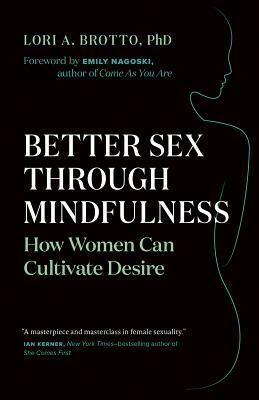
Books I Read in 2024
#15 - Better Sex Through Mindfulness: How Women Can Cultivate Desire, by Lori A. Brotto
Rating: 3.5/5 stars
As with one of my previous reviews about a book on menopause, I'd like to point out up front that the structure and content of the book assumes the reader is a cis woman and refers to the reader's body throughout under that assumption, which might be alienating to any reader whose physiology doesn't match, be they cis men or any trans or intersex person. "Woman" in this book exclusively refers to cis women; only in one section does it allude to the distinction between cis and trans women by using the term "natal women" in reference to the specifics of one study. Which isn't to say that the core subject matter isn't potentially useful for or applicable to trans women or trans people in general, or that the book is setting out to be trans-exclusionary; only that what little research is being done on this topic is focused on cis women as the group who needs it and would benefit most greatly from it. (Which, given that most clinical medical science is done on cis men as the default, is still a good thing in my mind, that any research on sexuality is being done with cis women as the focus.)
Since the take-home message of this book is "Mindfulness practice could probably improve your sex life, and also the rest of your life while you're at it," in my mind that's equally useful advice for everyone, but the mindfulness exercises in this book range from generic at the start (anyone who can eat solid food can do the raisin meditation) to guided exploration of the body in both nonsexual and sexual contexts, which are specific to cis women.
If that message seems obvious, why does it need a whole book written about the science that "proves" it, well, I'm still a crunchy science nerd at heart and was interested to see the design structure of the studies done to research the topic and the results of those studies. That sort of narrative would likely seem dry and boring to someone more interested in the self-help, instructional aspects of the book; likewise, the mindfulness exercises themselves might not interest someone who was reading this for the crunchy science, though the book is definitely marketing itself to cis women experiencing some level of sexual distress or dysfunction who are hoping for a solution, to whom the book offers mindfulness.
Without getting too personal on the subject, I was interested in this book on both fronts; as with my previous reading about menopause, I'm trying to be proactive about engaging with the changes in my body as it ages, and I have noticed a pattern of changes in my sex life that I'm not pleased with. I don't have access to the sort of highly regimented clinical mindfulness study that the book refers to, but the barrier to entry for self-guided mindfulness practice is basically nonexistent--I already have one app on my phone I could be utilizing but mostly don't, and if it turns out I don't vibe with their library of guided exercises I know there's a wealth of other options. And even those aren't necessary, they're just helpful tools.
I know that I, personally, will face challenges attempting mindfulness practice despite all its potential benefits--mindfulness is widely considered to be especially beneficial for people with ADHD, but also difficult for them, as the differences in the ADHD brain from a neurotypical one aren't conducive to learning to achieve a state of mindfulness. But another, narrower take-home message from this book was inspiring to me: that self-belief about your own state of sexuality and sexual satisfaction is more impactful to actual sexual satisfaction that any combination of other studied factors (relationship status, age and hormonal changes, etc.) The book repeatedly assures the reader mindfulness is learning to treat negative thoughts as "mental events" to be noticed, acknowledged, and then moved on from, which in a broader, non-sexually-specific context, means that even my belief that "mindfulness will be difficult for me because I have ADHD" isn't an obstacle that can't be overcome. Forming a habit of mindfulness practice might also be difficult for me, but again, that can be overcome to at least some degree with motivation, and all those scientific studies did show that women engaged with mindfulness showed strong desire and follow-through in making time for daily practice (even accounting for the self-selection of feeling the need to participate in the study in the first place.) The benefits of mindfulness appear to be their own reward, in terms of successful habit-forming, so I'm hopeful.
3 notes
·
View notes
Text

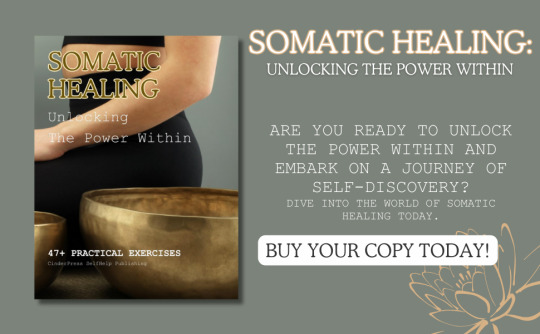
Somatic Healing: Unlocking the Power Within
Unleash on a transformative journey of self-discovery and holistic well-being with "Somatic Healing: Unlocking the Power Within." This insightful guide introduces you to the profound world of somatic healing—a practice that explores the intricate connection between mind, body, and spirit.
Key Features:
Delve into the roots of somatic healing, tracing its origins from ancient Eastern practices like yoga and Tai Chi to Western traditions of psychoanalysis. Uncover the threads that weave the body-mind connection into the fabric of human understanding.
Explore the scientific basis of somatic healing, unveiling the role of neuroplasticity, neurotransmitters, and the impact of stress on the body. Gain insights into the physiological mechanisms that underlie somatic practices and their transformative potential.
From breathwork and movement therapies to mindfulness meditation and expressive arts, discover a comprehensive mind-body toolkit. Practical exercises and guidance empower you to incorporate these techniques into your daily life, promoting relaxation, clarity of mind, and emotional resilience.
Navigate the intricate path of healing trauma through the body. Recognize and understand trauma, unravel the role of the nervous system, and explore somatic approaches that offer tools for transformative recovery.
Extend the journey of somatic healing into community spaces. Explore the social dimension, create somatic-centric communities, and witness the ripple effect of collective well-being.
Acknowledge the limitations, evolve with emerging trends, and engage in the ongoing quest for holistic well-being. This section challenges the status quo, fostering a spirit of curiosity and adaptation.
Be a catalyst for positive change, fostering resilience on a broader scale.
Somatic Healing: Unlocking the Power Within is a guide to transforming your relationship with your body, cultivating resilience, and contributing to a world where well-being is a collective endeavor. Are you ready to unlock the power within and embark on a journey of self-discovery? Dive into the world of somatic healing today. Get your copy today!
#somatic#trauma#mentalhealth#therapy#healing#somaticexperiencing#somatichealing#coping#counselling#dalmenysk#warmansk#rosthernsk#martensville#martensvillesk#hamptonvillage#saskatoon#oslersk#haguesk#saskatoonsk#the#counsellor#waldheimsk#eveningapptsavailible#lairdsk#blainelakesk#haffordsk#leasksk#nowbooking#langhamsk#hepburnsk
2 notes
·
View notes
Text
How to Stop a Dog From Barking When They’re Home Alone

It’s a common problem, but an annoying one: Your dog is well-behaved when you’re home. But as soon as you leave, they can’t stop making noise. Your dog has their reasons for acting out. Boredom, restlessness, fear, and separation anxiety are all common reasons that your dog might bark and whine while you’re gone. Wondering how to stop a dog from barking when they’re home alone? Try these tricks to distract or redirect their behavior from barking.
Make Sure They Get Exercise
Make sure you give your dogs enough exercise before you leave in the morning. Tired dogs are more likely to want a quiet rest time. If possible, have a dog walker come during the middle of the day to provide more exercise.
Try Toys and Canine Puzzles
There are a number of commercial and homemade products that give your dog something to do while you’re gone. You can stuff a hollow toy with a spreadable treat, like dog-safe peanut butter, and the dog will work to get the snack out. You can also hide dog treats in an interactive dog puzzle. Your dog may be too busy to bark, since they’ll be looking for their treats.
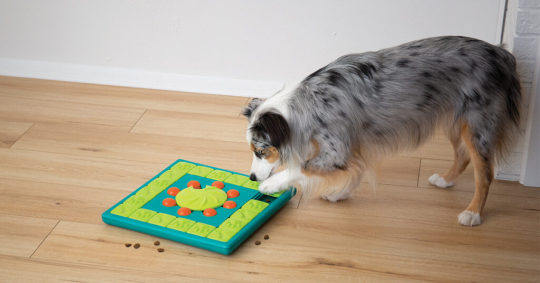
Turn on Familiar Sounds
For dogs who bark when owners are gone, trainers often suggest leaving the dog with some familiar sounds such as a radio or television. The idea is that these sounds resemble the household noises when the owner is present, which may reassure your dog.
Citronella Collars
Citronella collars spray a burst of citronella when the dog barks. Citronella is made from the oils of lemongrass, and it is often used in perfumes, candles, and incense. This collar is seen as a humane alternative to shock bark collars.
Anti-Barking Devices (Non-Collar)
There are several anti-barking devices that do not involve collars. These devices detect barks and sends a high-pitched sound that only dogs can hear.
What to Do if Barking Continues
If you try these solutions and your dog’s barking continues, you might need to play detective and explore beyond the simplest solutions. Keep in mind that as the dog’s trainer (or animal behaviorist), finding the function of the behavior is important. Once you identify what triggers their barking, you can go about reducing or eliminating that trigger.
If you’re not able to stop a dog from barking, you also may want to take your dog to the vet. They will be able to identify (or rule out) any underlying health issues.

What About Separation Anxiety?
A study on dog separation anxiety confirmed that this a complex problem. Remember that anxiety is a term that means your dog is sufficiently stressed that there will be some physiological signs that will be manifested by behaviors such as pacing, whining, panting or drooling.
Your smartphone can be a very useful tool for diagnosing the root of your dog’s behavior. Consider using a smartphone app like Barkio or Pet Monitor VIGI to observe your dog remotely, or a simple dog camera or monitor. By watching your dog’s behavior from afar, you’ll be able to see any signs of anxiety in your absence. You can also see if they bark when squirrels are in the yard, or if your dog gets destructive when they’re simply bored.
Separation anxiety can be a tough problem to treat — but these best practices can help you make inroads on the problem. Some of them are similar to the more general fixes for barking:
Exercise your dog vigorously before you leave. This allows your dog to rest well in your absence.
Leave “activities” to keep your dog occupied. Examples include a safe chew toy, or an interactive game where your dog works to get a treat out of a puzzle.
Provide training while you’re home. Leave the dog for a few seconds, come back into the house, and reward them for quiet, calm behavior. Add a few seconds at a time. Although this process does work, it requires a lot of patience. It’s a good idea to avoid adding too much time at once, since that won’t work.
Depending on the severity of your dog’s anxiety problem, you may want to talk to your dog’s veterinarian. They may prescribe anti-anxiety medications for your dog that you’ll eventually phase out.
Recruiting a professional dog trainer can also help. Training an anxious dog isn’t always easy, and your dog is very clued in to your mood. Involving a professional makes it easier for you to stay calm and relaxed, which in turn helps your dog stay calm too.
#barking dog#dog home alone#dog behavior#how to stop barking#excessive barking#separation anxiety in dogs#dog training#how to dog
2 notes
·
View notes